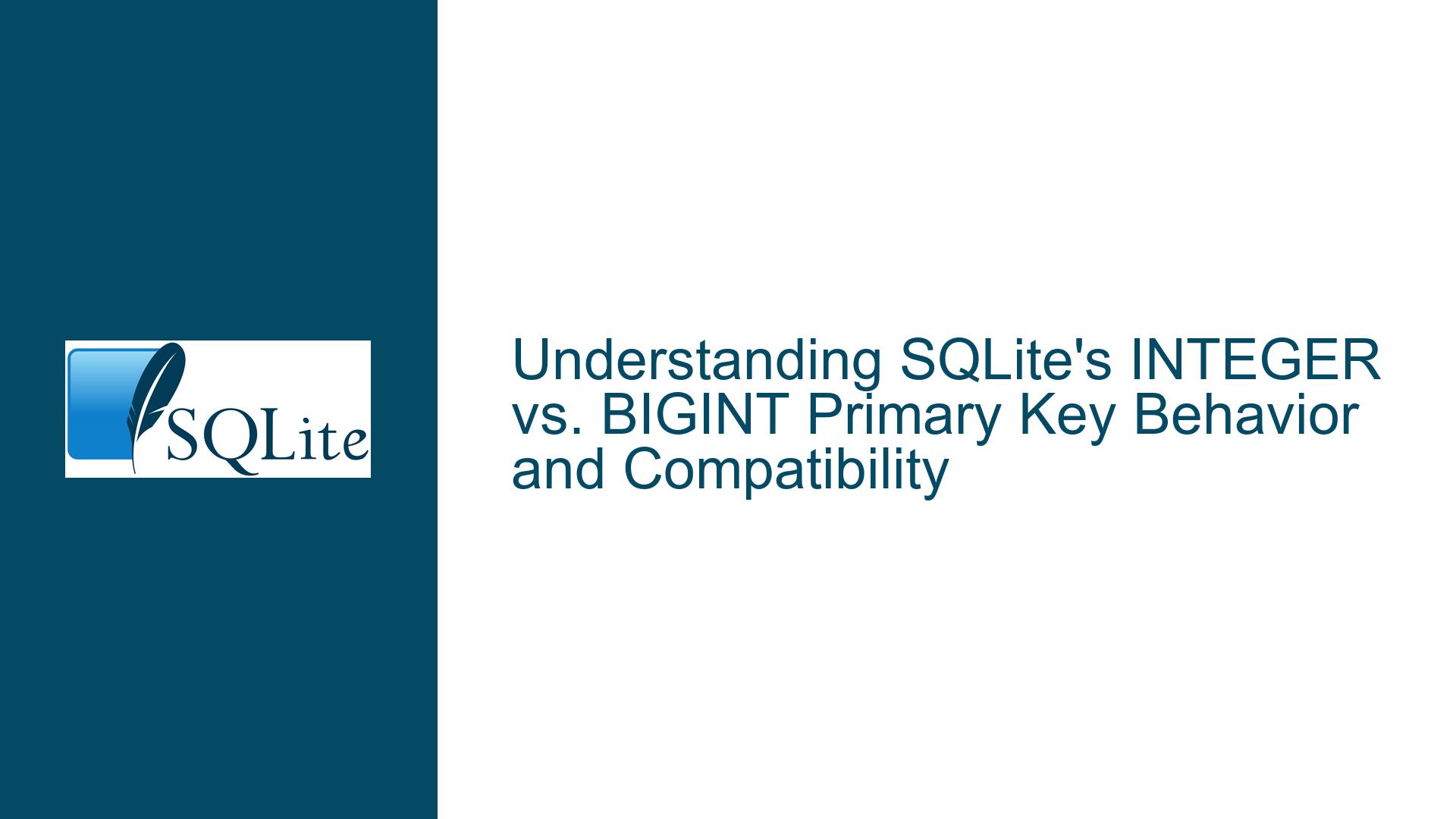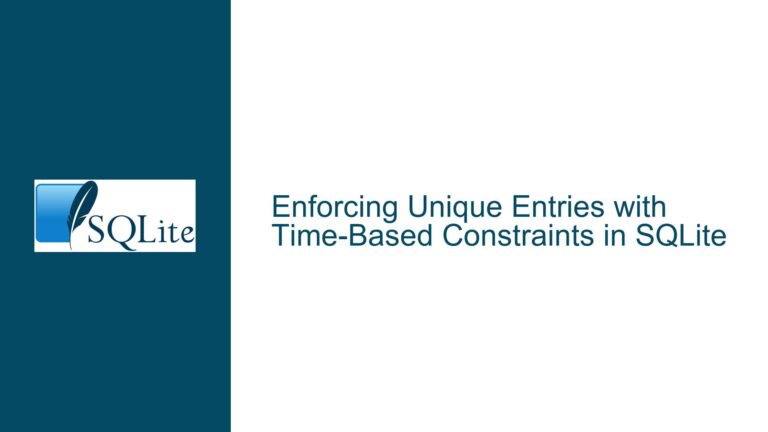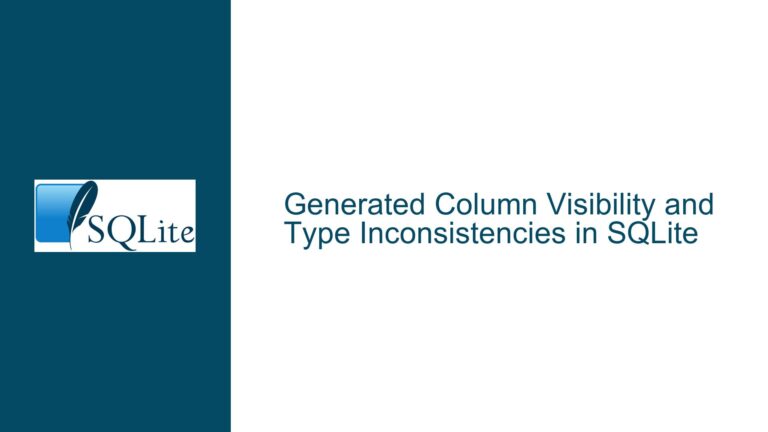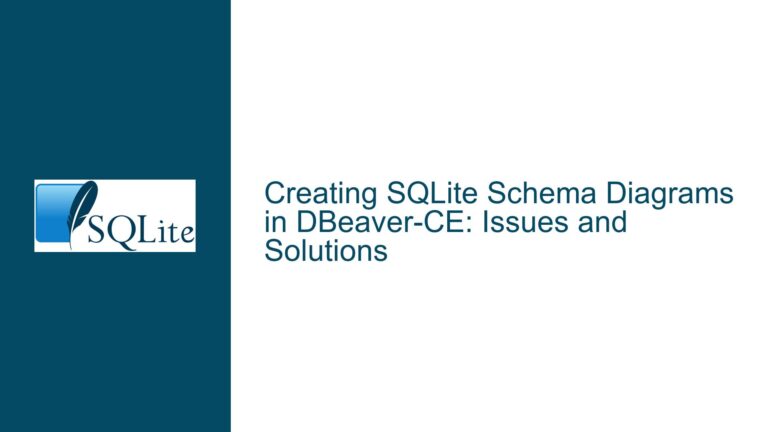SQLite’s INTEGER vs. BIGINT Primary Key Behavior and Compatibility
Technical Foundations of SQLite’s Primary Key Implementation and Cross-Database Schema Portability Challenges
The core issue revolves around SQLite’s treatment of INTEGER PRIMARY KEY as a special case tied to its internal rowid mechanism, contrasted with the behavior of other integer type declarations like BIGINT PRIMARY KEY. This distinction creates challenges when developers attempt to write database-agnostic schema definitions that work across SQLite and systems like PostgreSQL. At first glance, these appear to be mere syntax differences, but they have profound implications for data integrity, auto-increment functionality, and cross-platform compatibility.
SQLite implements a dynamic type system where column types are governed by type affinity rather than rigid storage classes. When a column is declared as INTEGER PRIMARY KEY, it becomes an alias for the internal 64-bit signed integer rowid. This grants three unique properties:
- The column automatically increments if no value is explicitly provided (unless
AUTOINCREMENTis used, which adds additional constraints) - The column strictly enforces integer-only values (via SQLite’s "numeric affinity" rules)
- The column cannot store NULL values unless the table is a
WITHOUT ROWIDtable
By contrast, columns declared with other integer-type names like BIGINT, INT, or SMALLINT receive "integer affinity" but do not alias the rowid. This allows them to store non-integer values through SQLite’s type conversion rules while losing access to automatic rowid assignment. The AUTOINCREMENT keyword is explicitly prohibited in this context because it requires tight integration with SQLite’s rowid tracking system.
The compatibility challenge arises when developers create schemas intended to work across multiple database systems. For example, PostgreSQL uses BIGINT to denote 64-bit integers and INTEGER for 32-bit values. A developer might reasonably declare a primary key as BIGINT PRIMARY KEY GENERATED BY DEFAULT AS IDENTITY in PostgreSQL and expect equivalent behavior from SQLite using BIGINT PRIMARY KEY AUTOINCREMENT – but this fails because SQLite reserves automatic incrementation exclusively for INTEGER PRIMARY KEY columns. This creates maintenance overhead as teams must maintain separate schema definitions or use complex migration tools.
Architectural Constraints and Type Affinity Rules Preventing Uniform Primary Key Handling
The fundamental causes of this behavior are rooted in SQLite’s design philosophy and implementation details:
1. Rowid Aliasing Mechanism
SQLite’s internal rowid (a 64-bit signed integer) can only be aliased by columns explicitly declared as INTEGER PRIMARY KEY. This is hard-coded in the parser (parse.y) and virtual machine (vdbe.c). The relevant code snippet from SQLite’s source shows how the parser checks for the exact INTEGER type name:
/* In parse.y */
if( autoinc && !isInteger ){
sqlite3ErrorMsg(pParse,
"AUTOINCREMENT is only allowed on an INTEGER PRIMARY KEY");
}
This check occurs during table creation, rejecting any non-INTEGER primary key with AUTOINCREMENT. The BIGINT type name triggers different affinity handling despite storing values identically to INTEGER.
2. Type Affinity vs. Storage Class
SQLite’s type system differentiates between a column’s affinity (declared type) and the actual storage class of values. While BIGINT and INTEGER both have integer affinity, only INTEGER PRIMARY KEY columns gain rowid aliasing. This leads to paradoxical behavior:
CREATE TABLE example (
a BIGINT PRIMARY KEY, -- Integer affinity, not rowid alias
b INTEGER PRIMARY KEY -- Rowid alias
);
INSERT INTO example (a) VALUES ('text'); -- Succeeds due to type conversion
INSERT INTO example (b) VALUES ('text'); -- Fails with "datatype mismatch"
3. Backward Compatibility Requirements
Changing BIGINT PRIMARY KEY to alias the rowid would break existing schemas that rely on its current permissive behavior. Consider legacy systems storing mixed data types in BIGINT primary keys – modifying this behavior would invalidate their data storage approach.
4. Cross-Engine Type Semantics
Different databases implement integer types with varying precision:
- PostgreSQL:
INTEGER(4 bytes),BIGINT(8 bytes) - MySQL:
INT(4 bytes),BIGINT(8 bytes) - SQLite: All integer types map to 8-byte storage
This makes INTEGER PRIMARY KEY in SQLite equivalent to BIGINT in other systems, creating a terminology mismatch that complicates schema portability.
Strategic Approaches for Schema Harmonization and Key Management
1. Explicit Type Mapping with Conditional DDL
Create database-specific schema definitions using preprocessing tools. For example, in a migration system like Flyway:
-- #if SQLite
CREATE TABLE users (
user_id INTEGER PRIMARY KEY AUTOINCREMENT,
name TEXT
);
-- #elif PostgreSQL
CREATE TABLE users (
user_id BIGINT GENERATED BY DEFAULT AS IDENTITY,
name TEXT
);
-- #endif
This approach preserves each database’s native auto-increment mechanisms while maintaining a single source file.
2. Standardized Type Names via Affinity Overrides
Leverage SQLite’s type affinity rules to use BIGINT while functionally achieving INTEGER PRIMARY KEY behavior:
CREATE TABLE compatible_table (
id INTEGER PRIMARY KEY AUTOINCREMENT, -- Actual SQLite implementation
bigint_id BIGINT REFERENCES other_table(id) -- Example of mixed usage
);
-- For cross-DB compatibility:
CREATE TABLE portable_table (
id BIGINT PRIMARY KEY -- Works in PostgreSQL
) WITHOUT ROWID; -- Forces SQLite to use explicit primary key
3. Application-Level ID Generation
Bypass database-specific auto-increment features entirely using application-generated UUIDs or snowflake IDs:
CREATE TABLE universal_table (
id BLOB PRIMARY KEY, -- Stores UUID bytes
data TEXT
);
-- Insert with application-generated UUID:
INSERT INTO universal_table VALUES (randomblob(16), 'sample');
4. Schema Validation Layer
Implement pre-deployment checks that validate primary key declarations against target database capabilities:
def validate_primary_key(column, db_engine):
if db_engine == 'sqlite' and column.type == 'BIGINT' and column.autoincrement:
raise InvalidSchemaError("SQLite requires INTEGER for autoincrement keys")
# Additional checks for other databases...
5. Type Casting in ORM Layers
Use object-relational mapping (ORM) systems to abstract type differences:
# SQLAlchemy example
from sqlalchemy import BigInteger, Integer
class User(Base):
__tablename__ = 'users'
# Map to BIGINT in PostgreSQL, INTEGER in SQLite
id = Column(BigInteger().with_variant(Integer, 'sqlite'),
primary_key=True, autoincrement=True)
6. Understanding Storage Implications
Educate developers about SQLite’s 64-bit rowid range ( -9,223,372,036,854,775,808 to 9,223,372,036,854,775,807 ) to demonstrate that INTEGER PRIMARY KEY already provides 8-byte storage equivalent to other systems’ BIGINT.
7. Migration Script Transformation
Create automated script converters that rewrite BIGINT PRIMARY KEY to INTEGER PRIMARY KEY when targeting SQLite:
function adaptSchemaForSQLite(sql) {
return sql.replace(
/(\bBIGINT\b)\s+PRIMARY\s+KEY\s+(AUTOINCREMENT)?/gi,
'INTEGER PRIMARY KEY $2'
);
}
8. Performance Considerations
Evaluate when AUTOINCREMENT is truly necessary, as SQLite’s default rowid allocation (without AUTOINCREMENT) provides better insert performance. Use AUTOINCREMENT only when requiring strict monotonic increment without reuse of deleted IDs.
9. Hybrid Key Strategies
Combine database-generated IDs with application-level type casting:
-- PostgreSQL/SQLite compatible table
CREATE TABLE hybrid_table (
id BIGINT PRIMARY KEY -- Works as BIGINT in PG, INTEGER alias in SQLite
);
-- Application code casts values to 64-bit integers
10. Documentation and Linting
Enforce primary key conventions through SQL linters and style guides that account for SQLite’s peculiarities. For example:
- "Always use
INTEGER PRIMARY KEYfor auto-increment keys in SQLite" - "For cross-DB primary keys, prefer application-generated UUIDs"
- "Reserve
BIGINTfor explicit 64-bit foreign key references"
By combining these strategies, teams can achieve functional schema compatibility while respecting SQLite’s implementation constraints. The key lies in understanding that SQLite’s INTEGER PRIMARY KEY is not merely a type declaration but a direct interface to its underlying storage engine – a design decision that enables exceptional performance for embedded databases but requires special consideration in heterogeneous environments.






